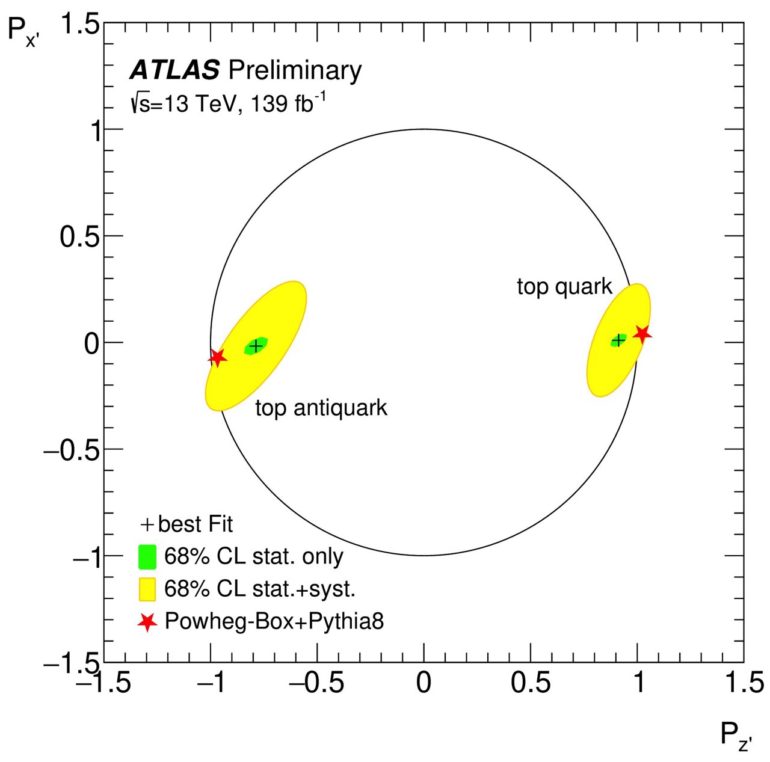Unique among its peers is the top quark—a fascinating particle that the scientific community has been studying in detail since the 90s. Its large mass makes it the only quark to decay before forming bound states (a process known as hadronisation) and gives it the strongest coupling to the Higgs boson. Theorists predict it may also interact strongly with new particles—if it does, the Large Hadron Collider (LHC) is the ideal place to find out as it is a “top-quark factory.”
While most top quarks are produced in pairs at the LHC, collisions will occasionally produce single top quarks. The LHC churned out more than 42 million single top quarks during its impressive Run-2 data-taking period (2015–2018). Unlike top-quark-pair production, single top quarks are always produced via the left-handed electroweak interaction. This impacts the produced top quark’s spin direction, and in turn, the spin of its decay products. By studying singly-produced top quarks, physicists are able to examine the degree by which a top quark’s spin is aligned to a given direction (its polarization). This parameter is particularly sensitive to new physics effects. In a new result presented by the ATLAS Collaboration, physicists have measured—for the first time—the full polarization vectors for both top quarks and antiquarks.
Tempest in a t-channel
Among the different mechanisms that contribute to single-top-quark production, the “t-channel” dominates at the LHC. In the t-channel, a top quark decays along with another particle, known as a “spectator quark.” This spectator is crucial for measuring the top quark’s polarization, since its direction of motion is expected to coincide with the top-quark spin direction—at least, most of the time. This is not always the case; further, the spin direction should differ between top quarks and antiquarks.
To fully understand this behavior, ATLAS physicists set out to measure the full top quark and antiquark polarization vectors. First, they had to distinguish between top quarks produced in the t-channel and other processes that leave the same signature in the detector. Researchers searched their collision events for the characteristic features of the t-channel; namely, events with two jets in the final state (the spectator quark and the bottom quark from the top-quark decay) or a spectator quark with large pseudorapidity. Their resulting selection is quite pure in t-channel singly-produced top quarks.
After its production, the top quark decays almost exclusively into a W boson and a bottom quark. The W boson will further decay to a pair of quarks (hadronic channel) or a lepton and a neutrino (leptonic channel). The leptonic channel is particularly interesting to physicists, as the angular distributions of the lepton are intimately related with the spin of the top quark. New results from the ATLAS Collaboration exploit this feature to provide—for the first time—the full polarization vectors for both top quarks and antiquarks (see Figure 1). There is a huge degree of polarization along the direction of the spectator quark’s jet for top quarks, and against that direction for top antiquarks.
Furthermore, ATLAS physicists measured the top quark’s differential cross section as a function of these angular distributions. Their measurements are provided in such a way that they can be directly compared with current and future theoretical predictions. Figure 2 shows one of the three differential cross-section measurements of the t-channel production as a function of the angular distributions of the charged lepton. The results are in agreement with Standard Model predictions.
Operator! Get me new physics on the line
ATLAS’s new analysis also makes important inroads in the search for phenomena beyond the Standard Model. In particular, new particles that cannot be directly produced at the LHC would still have a sizeable effect on the distributions measured in this analysis. Studying these gives researchers a model-independent way to describe possible deviations from the theoretical predictions in terms of operators, which are zero in the Standard Model.
Concretely, ATLAS researchers looked at the “OtW dipole operator.” This operator has both a real and an imaginary part; the latter being of particular interest, since it is not accessible in top pair production and non-zero values would imply a CP violation component in the top-quark sector. The new ATLAS result sets constraints on the real and imaginary part of this coefficient. At 95% confidence level, the real part is constrained within [-0.7, 1.5] and the imaginary part within [-0.7,0.2], both compatible with zero. For the imaginary part, the provided limits are the most stringent so far from high-energy experiments.
ATLAS experiment searches for ‘charming’ decay of the Higgs boson
More information:
Complete measurement of the top-quark polarisation in t-channel single-top-quark production using proton-proton collisions at 13 TeV with the ATLAS detector (ATLAS-CONF-2021-027): atlas.web.cern.ch/Atlas/GROUPS … ATLAS-CONF-2021-027/
Citation:
ATLAS experiment measures top quark polarization (2021, June 23)
retrieved 24 June 2021
from https://phys.org/news/2021-06-atlas-quark-polarization.html
This document is subject to copyright. Apart from any fair dealing for the purpose of private study or research, no
part may be reproduced without the written permission. The content is provided for information purposes only.



